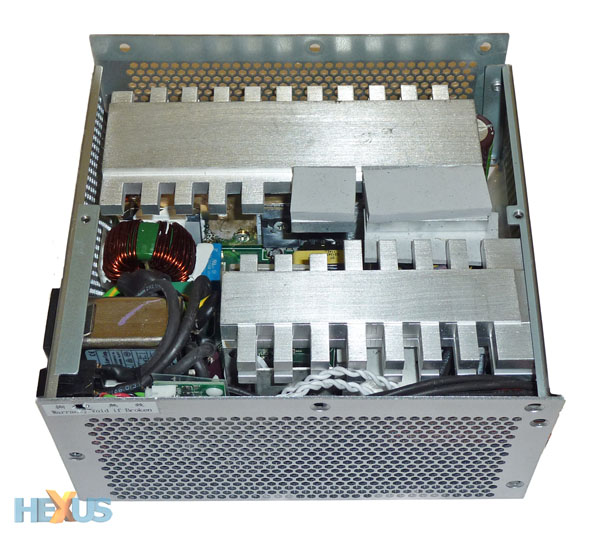No fans here
HEXUS has looked at all manner of PSUs in the last year, citing near-silent operation as a bonus on premium models. Most quality PSUs have well-tuned fans that barely emit a hum when running at below 50 per cent of their capacity, while others have a semi-fanless cooling architecture, where the fan switches off if the PC is in an idle, low-power state. But the quiet-computing aficionados - and they are many now - prefer the altogether-silent treatment. To this end, SilverStone, perhaps better known for chassis, is keen to promote its silent PSUs.This here 'industrial-class fanless power supply' is the £130 SST-ST50NF, better known as the SilverStone Nightjar 500W. Measuring 160mm x 150mm x 85.8 mm (LxWxH) and weighing in at a not inconsiderable 3.5kg, the premise here is to deliver relatively high efficiency and, therefore, keep PSU-produced heat to a minimum. Armed with masses of aluminium and, as you will see later on, also loaded with chunky heatsinks, the Nightjar feels suitably well-designed for the task.
SilverStone reckons the supply is between 82-85 per cent efficient across a 20-100 per cent load range, peaking at mid-load levels, which are high enough to provide the Nightjar with 80 PLUS Bronze certification. Bear in mind that the supply is rated to provide the full 500W at an ambient 25°C temperature, which is lower than most premium fan-assisted models, and SilverStone's documentation suggests that one needs to 'increase external forced air cooling' if the ambient temperature rises above this figure. Leading on from this, the unit automatically reduces maximum available capacity down to 350W if ambient temperature rises to 35°C, powered from a 115V AC source, or an ambient 45°C from a 230V AC source.
The thick aluminium top-plate acts as an obvious heatsink; it is thermal pad-connected to an array of other 'sinks inside the chassis. Appreciating that it can get hot - and is doing its dual-purpose job as a heatsink - the uppermost of the two LEDs lights up red when the PSU chassis' temperature exceeds 55°C. This warning light is sensible, too, as the top-plate can become very warm. Note, also, the PSU automatically shuts down if temperature hits 90°C.
Aiding heat-escaping efforts is the honeycomb structure on the sides, which is a little more obvious here than on regular PSUs. We'd suggest having some airflow directed towards the PSU-housing section in any case; it's a sensible move if you need to pull more than 50 per cent of the capacity on a regular basis, especially if ambient temperature begins to creep up.
Cables are hard-wired into the chassis and they unfurl as follows:
| Cables | Cables, type, length, plugs on cable | |||||||
|---|---|---|---|---|---|---|---|---|
| Main | 20+4-pin (55cm) x1 cable | |||||||
| ATX/EPS | 4+4-pin (58cm) x1 cable | PCIe | 6+2-pin (51cm) x1 cable 6-pin (66cm, same cable) x1 cable |
|||||
| Peripheral 1 | 3x SATA (53-83cm) x2 cables - 6 in total | |||||||
| Peripheral 2 | 3x Molex (50-90cm) x2 cable - 6 in total Both Molex cables also include 1x Floppy each |
|||||||
One cable provides a single 6+2-pin and 6-pin connector for graphics-card usage, and this means you'll be able to run up to two mid-range cards or a solitary high-end card from the get-go. A couple of SATA cables each have three connectors a-piece, and six is plenty for most average builds. Similarly, 6 Molex and 2 Floppy are also good, though we'd like SilverStone to spend that little extra and ensure that sleeving goes fully into the casing; it stops rather short on this model.
Remove the top aluminium plate and huge heastinks dominate the view. The top-plate has the necessary thermal pads to ensure that the underlying heatsinks make effective contact with it. Having a good peek inside shows that SilverStone, in co-operation with ODM manufacturer SevenTeam, has done a good job in sticking thermal pads practically everywhere it can.
Primary capacitors are from Nippon Chemi-Con and rated to 105°C. We often trot out that figure and then almost dismiss it as PSU internals rarely become that warm. However, in this case, using high-temperature-capable caps is a must. The proof of the supply's quality, we suppose, will be in the testing.
Amps/watts and voltage |
3.3V |
5V |
12V1 |
-12V |
-5VSB |
|||
|---|---|---|---|---|---|---|---|---|
Rail amps |
18A |
18A |
38A |
0.5A |
2.5 |
|||
Maximum rating |
120W |
456W |
6W |
12.5W |
||||
Maximum rating continuous |
500W @ 25°C ambient |
|||||||
The single-rail 12V topology indicates that a tasty 456W can be pulled from the 12V line, which is more than enough to power a solid Intel or AMD build, complete with high-performance graphics card. The unit is backed by a standard three-year warranty, by the way.












